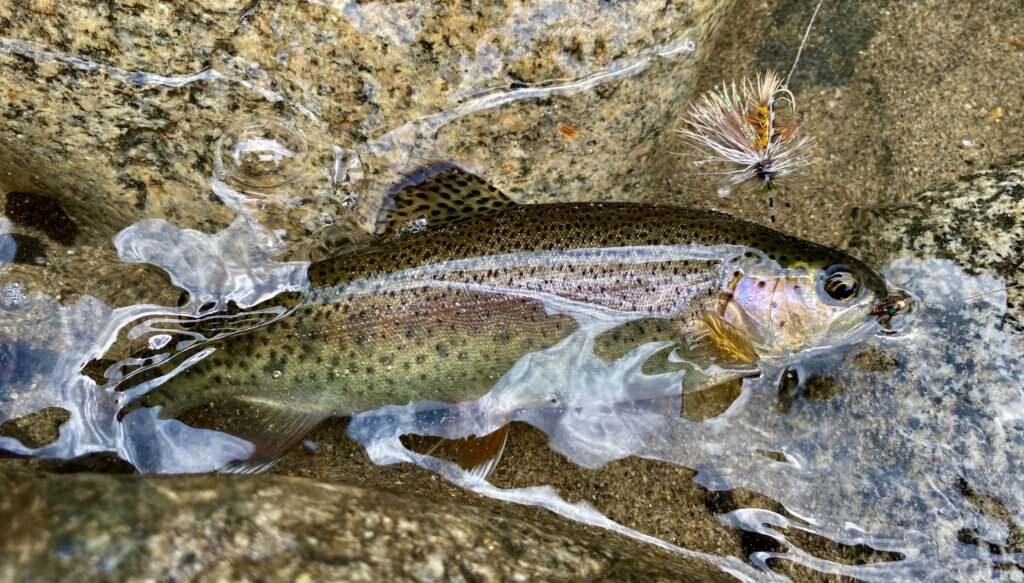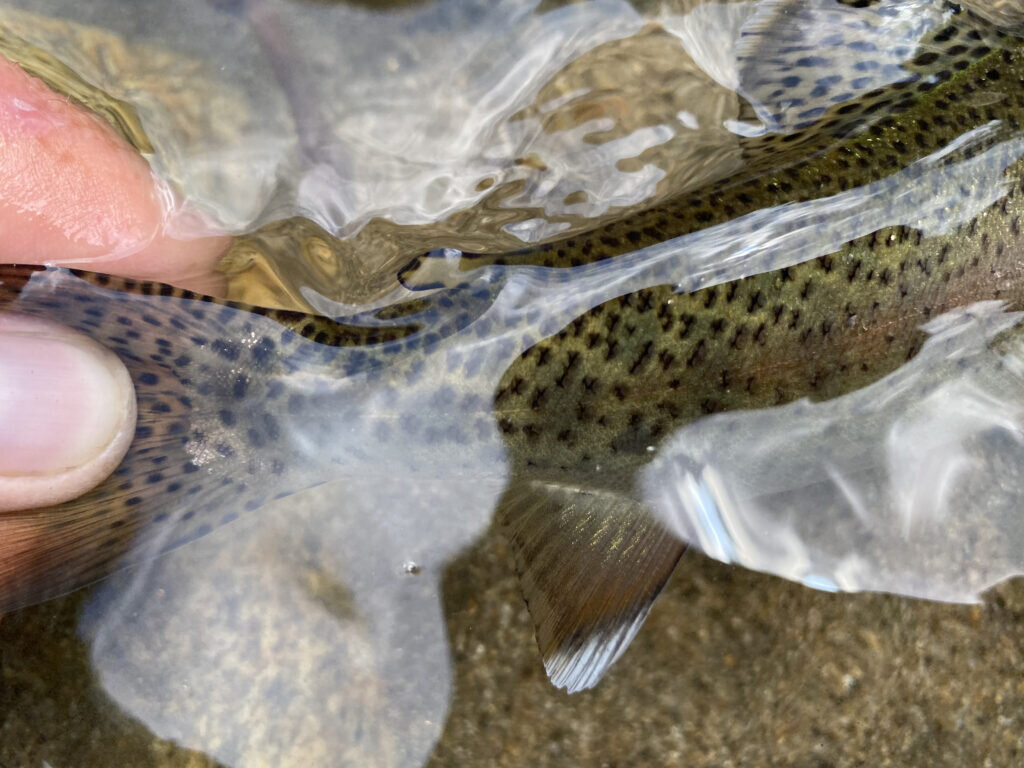The 117 Degree Kern River Melting Pot
What rainbow trout can teach us about engaging native fish, salads, diversity and river towns.
Published by Trout Unlimited - July 2021
As I slowly descended from the high desert into California the thermometer in the truck showed 117-degrees as I crossed the border from Arizona into the bleak landscape outside Needles.
I was headed to Kernville, Calif., a few miles west of one of my favorite thoroughfares in the entire West, US-395. Highway 395 passes directly through the shadow of Mt. Whitney–the highest mountain in the contiguous United Statets — as you pass by the breathtaking southern Sierra Nevada range.
Life in Kernville revolves around the river and, upon arriving in town, one could easily see that revolution was slow. Temperatures had been above 100-degrees since before anyone could remember and the generally abundant runoff from the Sierra Nevada mountains enveloping Kernville and responsible for the formation of the Kern River had been gone for months. The air burns the throat and it was eerily silent. No children were playing on the riverside. Dust swirled in the street and the abundant outdoor patios built for tourists to enjoy the world-famous California sun were all empty.
Fishing for native rainbow trout in California. Daniel A. Ritz photo.
The day before my arrival, I made a call to my college roommate Steve Merrow, a world-class whitewater rafting guide, who now works for Sierra South in Kernville.
“They just lowered the release on the dam for the (Lower Kern River),” he said. “Yesterday they lowered it to about 90 cubic feet-per-second (CFS), essentially ending my season. Looks like I might be able to hang out a little bit more now.”
After hanging up the phone, I was shocked by his calm demeanor as he casually told me there wasn’t enough water to support his and most of the town’s way of life. I suppose he had been suffering the consequences and preparing for this loss for some time.
While I knew that my old friend was a devoted riverman and skilled navigator, I also knew he didn’t know his ass from his elbow about trout fishing.
So, almost immediately after getting into town, I walked around the corner from his house to Kern River Fly Fishing.
Upon entering the famous fly shop, I was greeted by Rob Buhler, a guide and fly tier for Kern River Fly Fishing. I introduced myself, explaining my project while desperately attempting to show that I had done my research and humbly deserving of his infinite mercy and pity.
You see, I was in need of serious help.
“I had a plan. But, everyone has a plan until they get punched in the face,” I told Buhler, quoting heavyweight champion Mike Tyson.
“Well, you’ve come to the right place, and I’m the right guy,” Buhler quickly responded. “I don’t have easy answers for you, but I have some ideas.”
y experience with Buhler was one of those defining moments that exemplified why I firmly believe a “shop” is different from a “store.” The long-haired and soft-eyed Buhler walked me around the shop showing me various topographic maps and detailed trails.
As Buhler showed me the “usual” spots, all the standard and most easily accessible areas to pursue California’s native trout, I realized in a way, the walls of this fly shop contained answers to all the secrets anyone could ever need. The conversation, the customer service, the community, that was icing on the cake. The keys to unlocking the experience of Kernville’s native trout were literally plastered on this building’s walls if you took the time and knew how to read them.
Sadly, a majority of the easily accessible spots were seeing extraordinarily high water temperatures and even some fish kills at the more stagnant sections.
“If I was you, I would head up to Johnsondale Bridge and hike north well into the canyon,” Buhler said. “There are some stocked rainbows that might be sprinkled in as they are getting moved around with the low water and high temperatures in the lower section below the diversion dam, but if you get in that canyon a few miles, that’s where you’ll find the natives. And trust me, there’s no mistaking them.”
Over the course of my career in journalism, this is a mistake I’ve learned that I have a tendency to make. When someone tells me that something will be obvious, for some reason, unknown to me, I trust them. In fact, it is almost never obvious.
However, on this occasion, intuition served me and Buhler’s advice was sound. After hiking more than 3 miles upstream through the evening California sun to beat the midday heat, I came to a beautiful section of pocket water with cool waters.
It wasn’t long until my oversized yellow stimulator disappeared below the surface of a pool behind one of the now-exposed giant boulders that would normally be an underwater feature of the river for kayakers and rafters.
The fight was on, even before seeing it there was no mistaking it was a wild rainbow.
A Kern River rainbow trout. Daniel A. Ritz photo.
Historically, the Kern River rainbow was once the most abundant and widespread trout in the upper Kern Basin and grew to large sizes.
Since the 19th century, over-exploitation, combined with habitat degradation and, most importantly, hybridization with other trout, the population has been reduced to a small fraction of historic numbers.
To add insult to injury, not only are Kern River rainbows susceptible to hybridization with the two subspecies of golden trout that naturally crossover, Kern River rainbows are often misidentified or at least not recognized as unique as a species native and unique only to California due to the prevalence of stocked rainbow trout raised in hatcheries and then released all over the world.
This particular juxtaposition was really interesting to me. I have never, and likely will never be able to claim to be a taxonomist, geneticist or biologist, but the public acceptance of “rainbow trout,” as a blanket and overarching name for a species undermines the uniqueness of the California native trout experience.
While it is understood that the original hatchery and therefore hatchery-origin fish for stocking purposes were McCloud River rainbows from northern California, the history of the rainbow trout in its native California waters is dynamic, complex and very interesting.
It is my understanding that. at their root, all rainbow trout can originally be traced to coastal rainbow trout (Oncorhynchus mykiss irideus). Geologic history, along with individual pressures, has resulted in various genetic isolation events causing differentiation to the point where the Kern River rainbow are more genetically similar to its Kern River and Kern River adjacent species the California golden trout and Little Kern Golden trout than the coastal rainbow trout.
Interesting as it is, I’ve affectionately said a number of times while researching this project that genetics “isn’t the hill I’m going to die on.” My interest in the native rainbow trout of California, of which there are a few varieties in addition to the Kern River rainbow, wasn’t purely taxonomic in nature.
Back on the upper Kern, I quickly got my fish to the net as the sun was setting behind the canyon’s western wall.
Buhler was right. There was absolutely no mistaking it. The Kern River rainbow has a vibrancy in color, all of its colors, that simply isn’t present in its hatchery imposters. The back of the fish was more densely clustered with darker and more defined spots, the rose coloring along its lateral line was more clearly defined and the most telltale mark, the white edges along its fins, were clearly defined.
The clearly defined white edges of the fins of a Kern River rainbow trout. Daniel A. Ritz photo.
Unfortunately, there is a very real chance that Buhler won’t be able to make that claim, and anglers won’t be able to trust it, for much longer.
CalTrout says there are indications the Kern River rainbow trout could become extinct as a genetically unique species within the next 50 years.
As the sun continued to set and the air temperature continued to drop, I thought of how long a hike I had to get back to the truck. Along that long walk back, I thought of a story that Roger Bloom, the Inland Fisheries manager for California Department Fish and Wildlife, had told me weeks earlier during a phone interview.
Bloom shared that back in the early 1990s he worked for the wild trout program and attended many fishing expos and meetings. He remembers that the California Department of Fish and Wildlife had a poster with the native species.
A Kern River rainbow trout. Daniel A. Ritz photo.




